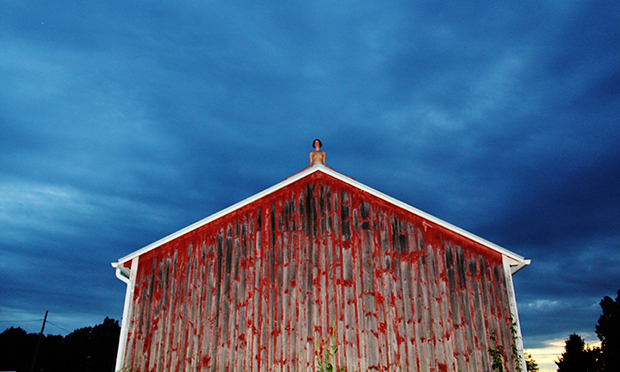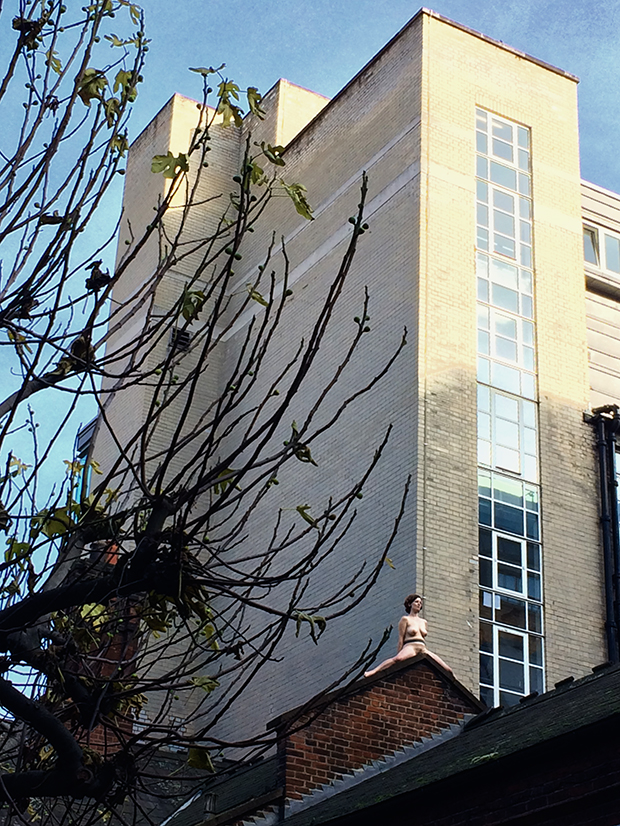
In November the artist Poppy Jackson made headlines around the world when her performance piece Site, which she presented at the SPILL 2015 festival of performance in London, provoked extensive media coverage. Jackson sat naked astride the gable of Toynbee Hall in Whitechapel across two days in four-hour stints, a durational performance that was observed by the crowds that gathered in the courtyard and those in the surrounding buildings. A single tweet from a worker in an office looking over the performance snowballed into extensive tabloid coverage, international news stories, and television appearances for the artist and her work. As I wrote in a previous piece for the East End Review, media interest overtakes and obscures the art all too often in such situations. I met with Jackson to discuss the piece, her wider practice, and what comes next after a brush with viral fame.
Lewis Church: Before we talk specifically about Site, could you speak a little bit about your artistic background, and your practice as a whole?
Poppy Jackson: Well my mum is an artist actually, so I’ve always grown up with her making paintings and prints and helping her with exhibitions. That has been a really big influence, inspiration, and a huge source of support. During high school and A-levels I decided I really wanted to do art, although mainly painting and drawing rather than performance. It wasn’t until I went to Dartington [College of Arts] in Devon that I began seriously making performance. My 2D work also continued in tandem with the performance, and the paintings and drawings have also always been on the subject of the body. Eventually it just made sense to experiment using my own body, and so the paintings got bigger and I was using my own body to do them, painting with my hands and my hair. It then became more about the process of making a work and what was going on physically than about just the body.
LC: There seem to be a number of artists in the UK right now who are returning to the body. Do you think that has something to do with how our lives work now? With the mediation and fragmentation of social interaction?
PJ: I think so. It is a good way to return to a really basic form of communication with each other, to return to the body. It’s also to do with a lot of the jobs we are doing. I now spend a hell of a lot of time on the computer, writing applications and things. So to really feel present in your body and using that is the best antidote.
LC: Are there artists working in the UK at the moment with whom you feel a strong kinship, in terms of your strategies, and the concepts you are working with?
PJ: Definitely. When I moved to London I met the performance artists Bean and Benjamin Sebastian, and became an Associate Artist at ] performance s p a c e [. So that venue has definitely been a kind of home for me. And there are so many artists who have been through that space, whose work I’ve witnessed and been so massively inspired by. Sinéad O’Donnell, Alastair MacLennan, Mark Greenwood, Bean and Benjamin themselves, Hugh O’Donnell. Even if it’s not work that I think is like what I do, to witness somebody going through a raw act of communication using their body is an incredibly special experience.
LC: I’d like to stay away from the publicity and tabloid reaction to Site and think more about the artwork itself. What do you do during the piece, and what do want the audience to see?
PJ: In Site I was in position on a building that people could move through, an inhabited building. People could use the architecture themselves to look around the piece, climbing the interior stairwell for example, to look down on my body and see where I was positioned amongst the buildings. It was a public space, and you could also see me on the roof from the street. I think it’s extremely different when you witness it live because the people there with you go through an experience as well. They have some kind of empathy, they can feel the temperature even with their coats on, and so as a live experience you can kind of tell what the performer is going through.
The idea had been cooking since about 2010 when I did a sketch, using my menstrual blood as paint on the paper. I didn’t know that it was going to happen on architecture though, as I didn’t yet know what that steeple shape was. I did a version of the piece called Hay Barn in Rosekill, New York, where I was on an amazing 1940s hay barn looking down. Myself, Jill McDermid-Hokanson and Tif Robinette curated the weeklong festival ESSENTIAL DEPARTURES, where fifteen artists (some of whom had never made performance work before) delved in and created incredible work in 100 acres of wild land. My piece there was a very similar action physically, but actually very different because the isolated context was completely opposite to Site in London.

LC: Obviously the piece has reached a huge number of people, far more than you might have originally expected. But to go back to the actual audience who were there, what were you hoping that they would experience or take away?
PJ: I was hoping it would be a very positive experience, but also something that would critique the fact that a naked body is a problem in our culture. A celebration of that body on its own terms is not something that we usually see, especially in public space. All of the female bodies that I normally see in public spaces are trying to sell something, or shown in a way that is really alien to how I feel about my body. There is this connection between consumerism, capitalism and the female body, where the body is devalued by being the thing that sells something, like a blank canvas. I was trying to critique all of these things and cut through them by placing a real body there. I don’t want my work to just be an attack or to just point out negatives though.
LC: How does that relate to performing on the roof of Toynbee Hall? I read that you were thinking of the radical history of Toynbee as being something that contributes to that feeling of challenge, but also as something positive.
PJ: For sure. Toynbee was built as a radical centre in the 1800s, to train future leaders so that they had the potential to bring about social change. I think the legacy of that and the special energy of the place remains, especially when you think about its social role now with local women’s groups for example, and the input of ArtsAdmin, which is based in the building. It’s amongst local businesses and flats in the East End and I wanted the performance to be seen by a non-arts audience as well as the festival audience. I also used to work down the road so this location has personal significance too. I’ve always had a job on the side, like most artists do to fund their practice.
LC: Has the experience of Site affected your plans for the future, and what you might do next? I remember when I talked to you during the festival that you said it had almost become two pieces, the media reaction and the performance itself.
PJ: Exactly, because there were people who’ve only seen the piece through the media coverage, and they’ll be thinking completely different things from someone who was there and witnessed it. One thing I’ve got to think about now is the side effect of this work, all the media attention, and how that affects the next piece. It’s something I’ve really got to think about. Even I only know my experience of it, I don’t know what it was like for those witnessing it from the stairs or on the ground. It has become two related but distinct pieces, and the documentation like the photographs and video, are very different from the performance. I think that if people witnessed it live they’d see that actually it was a very quiet piece, that it was very still, and really wasn’t about trying to shock anybody.
I think maybe doing the piece again live will provide another way for people to witness the work. It’d be great to do it again, but I’ll leave a little while to process everything before I return to it. I have some really good sites in mind, but I want to go back to painting before that. I go through cycles with performance, I return to painting and then back again. I’m working on a series of paintings at the moment, pieces that link very strongly to my performance work.Then I plan to return to Site.
Documentation of Site is available at spillfestival.com/spill-tv
poppyjackson.co.uk
